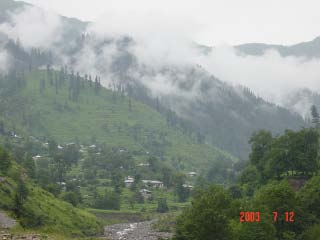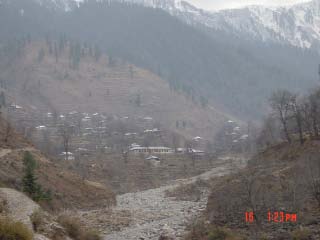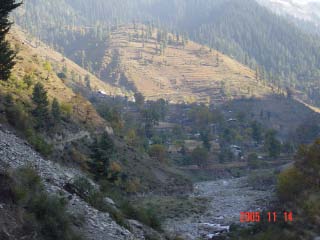|
23-Nov-2005
Background:
The road from
Balakot onwards into the Kaghan Valley had remained blocked for more than a
month after the earthquake. There were massive landslides between Kawai and
Ghanol, which were a major challenge for the Army Corps of Engineers to
overcome. With no road link to the majority of the Kaghan Valley north of
Kawai, desperate conditions had been created with difficulties in both
getting relief goods to the earthquake survivors and the ability of the
local inhabitants to evacuate/migrate themselves out from the Valley.
 |
Once the main
road of the Kaghan Valley had been opened to Jeepable traffic, which is
still the situation today, we came to know that there were still
off-shoot valleys that were landlocked. One such valley was Bhunja
Valley, a cluster of approximately 50 Villages, with a population of
around 15,000 inhabitants, 4Km crows flight inwards in a south
eastwardly direction from Faridabad on the main Kaghan Road. A Need
Assessment visit was arranged with the help of Dr Jamil Yusuf, whose
ancestral village was Seri Bagh, a hamlet in the Bhunja Valley. Dr Jamil
Yusuf had made tremendous contributions by personally working in Bhunja
immediately after the Earthquake. |
Journey to Bhunja:
The only way to get
in to Bhunja Valley is either by foot from Faridabad or by Helicopter. On 18th
November, 2005, we boarded a
Pakistan Army MI-17 helicopter at Shawal Najaf (Balakot) for a free ride to
Bhunja. We left at 11:15 AM and arrived after a short detour shortly after
noon.
|
En route, the
aerial view presented a different horizon to the magnitude of the
devastation. The total destruction of Balakot took on a new meaning.
Furthermore, there were make shift shelters or tents scattered
everywhere, even on seemingly inaccessible hilltops. |
 |
Findings in Bhunja Valley:
• 100% of the households and buildings
were either totally demolished or uninhabitable.
• There were a total of five schools (4
Government run and one private). There were separate primary schools for
Girls and Boys, but the Middle School (upto Grade 8) was a co-education. All
have been destroyed and there is currently no schooling. The schools
normally close for a longer winter break starting in mid-December and
re-open in March.
• About 60% of the population had already
migrated to lower lying areas like Balakot, Mansehra and Abbotabad. Many
more were planning to leave within the next 15 days. It is estimated that
more than 75% of the local population will leave the area to spend the
winters in lower lying cities or with relatives working in various cities of
Pakistan.
• The corn crop, which is a major
subsistence crop of the region, had been harvested or was in the final
stages of harvest. It is expected that many of the remaining families would
leave the area once they had harvested and stored their Maize crop.
• Several household had already built make
shift winter shelters out of the rubble of what was available from their
destroyed homes. Most of such families were from those who were economically
better off than others in the area. Many such families had “second” homes in
some of the cities like Abbotabad and Mansehra.
• It is anticipated that at least one
family member from each household would remain behind during the winter to
protect whatever belongings remained. Such individuals would be living under
very difficult conditions.
• Approximately 20% (+/- 5%) of family
households were adamant NOT to leave the area for the winter period and were
prepared to stay in their makeshift homes. The total population that would
eventually remain throughout the winter months would be between 3,500 and
5,000 people. There are reasons for great concern for such families,
especially for the very young and elderly.
 |
• The
approx 5-6 Km local link road from Faridabad (on the main Balakot -
KaghanRoad) to Bhunja has been destroyed due to several landslides. The
road on most ofthe landslides can be repaired using mechanised earth
moving equipment. There is however one main landslide approx 1.5 to 2 Km
from the main hamlet of SeriBagh towards Faridabad, which will require
to be bypassed by routing the road alongside the Bhunja Nala river. This
bypass section of the road would not be greater than 500m. |
• There are two wooden bridges on which
the link road crosses over the Bhunja Nala River. These two bridges appear
to be in sound structural condition but may not be able to bear the weight
of very heavy earthmoving equipment. There are several landslides either
side of these bridges, which would need consideration on whether or not
heavy earthmoving equipment should be allowed to pass over these wooden
bridges.
• The revival of economic life will take
some time in Bhunja. However, steps to bring about “normalcy” to those
living in the area would require the link road to be re-opened. Without this
road link being re-opened, the local community is 100% dependant on
helicopter flights for everything from food, shelter, clothing, medical aid,
etc. With the weather changing for the worse and a reduction in the number
of available helicopters, this makes the opening of the link road a major
priority. Other steps like encouraging water mill owners to re-establish
their damaged water mills will allow local residents to use the corn
harvested during the winter months in case food relief aid is suspended in
the region. Local shop keepers who are willing to re-open their shops are
unable to re-stock their shops after all their inventories have been sold or
consumed due to the lack of a land/road link.
•
Confidence in the local Nazim was very low. Most local inhabitants had
little or no expectations from him. He was not present in Bhunja for all the
three days that we were in Bhunja.
• A local community based organisation
comprising of various village elders from several hamlets had gained some
respect in the community and appeared to be the only organisation on ground
prepared to fill in the gap created by the absent Nazim.
• The Army at Bhunja had initially worked
under difficult circumstances and were not well accepted by the locals.
However, after continued efforts and persistence, the locals now understood
the Army presence as the only real source of Aid. Based on our assessment,
the Army is the only honest broker on ground.
•
There was limited damage or disruption to water sources in comparison to
those seen in other earthquake-affected areas. Nevertheless, the lack of
proper houses or shelters and limited water storage facilities has made
sanitation and general cleanliness a low priority with the locals. This has
resulted in an epidemic of Scabies and Impetigo, especially amongst the
children.
• There is no resident medical aid
available to the entire Bhunja community. The local Basic Health Unit is
destroyed and there was no doctor or healthworker available to the
community. This fact, plus the winter ahead, may result in an epidemic
spreading in the region. Many children and the elderly were already
suffering from acute respiratory infections as a result of being exposed to
the cold winter nights and poor shelter conditions. If they remained
untreated, not only would this spread more rampantly within the
community, but also many children would develop acute life threatening
conditions. During our stay at Bhunja we came across several cases of
pneumonia to whom antibiotic treatment was prescribed.
Conclusion:
• Basic Relief Aid (food, shelter, warm
clothing) would need to continue to be supplied by helicopter or animal
transport to the local community throughout the winter months and for as
long as a reliable land road route is not made available to the local
population.
• The local population needs to be
encouraged to seek shelter in lower cities or tented villages like Jabba.
However, most of the population had already migrated and others were to
follow soon. However, it was clear that the vast majority of those who had
intentions to migrate had done so with a minority of those remaining to
follow.
• A medical camp, manned by trained nurses
or dispensers needs to be established with a qualified doctor visiting at
least once a week. A resident local community lady health worker needs to be
identified most immediately. None seemed to be present. >
•
The local link road between Bhunja and Faridabad needs to be reopened at all
costs immediately.
|